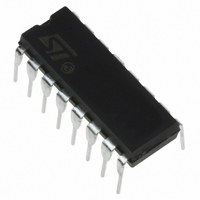L6599N STMicroelectronics, L6599N Datasheet - Page 15

L6599N
Manufacturer Part Number
L6599N
Description
IC RESONANT CONVERTR CTRLR 16DIP
Manufacturer
STMicroelectronics
Type
Phase Shift Resonant Controllerr
Datasheet
1.L6599DTR.pdf
(36 pages)
Specifications of L6599N
Applications
Resonant Converter Controller
Voltage - Supply
8.85 V ~ 16 V
Current - Supply
3.5mA
Operating Temperature
0°C ~ 105°C
Mounting Type
Through Hole
Package / Case
16-DIP (0.300", 7.62mm)
Number Of Pwm Outputs
1
Switching Freq
500KHz
Operating Supply Voltage (max)
16V
Output Current
800A
Operating Temperature Classification
Automotive
Mounting
Through Hole
Pin Count
16
Package Type
PDIP
Number Of Outputs
Single Output
Switching Frequency
500 KHz
Operating Supply Voltage
8.85 V to 16 V
Maximum Operating Temperature
+ 150 C
Minimum Operating Temperature
- 40 C
Mounting Style
Through Hole
Supply Voltage Range
8.85V To 16V
Digital Ic Case Style
DIP
No. Of Pins
16
Operating Temperature Range
-40°C To +150°C
Svhc
No SVHC (15-Dec-2010)
Base Number
6599
Device Type
Power
Rohs Compliant
Yes
For Use With
497-10542 - BOARD EVAL BASED ON L6599497-8429 - BOARD ADAPTER L6599/STP12NM50N497-8265 - BOARD EVAL BASED ON L6599497-5857 - DEMO BOARD FOR L6599497-5856 - DEMO BOARD FOR L6599497-5497 - EVAL BOARD FOR L6599497-5496 - EVAL BOARD FOR L6599
Lead Free Status / RoHS Status
Lead free / RoHS Compliant
Voltage - Input
-
Lead Free Status / Rohs Status
Compliant
Other names
497-5723
L6599NR
L6599NR
Available stocks
Company
Part Number
Manufacturer
Quantity
Price
L6599
7
Application information
The L6599 is an advanced double-ended controller specific for resonant half-bridge
topology. In these converters the switches (MOSFETs) of the half-bridge leg are alternately
switched on and OFF (180° out-of-phase) for exactly the same time. This is commonly
referred to as operation at "50 % duty cycle", although the real duty cycle, that is the ratio of
the ON-time of either switch to the switching period, is actually less than 50 %. The reason
is that there is an internally fixed dead-time T
MOSFET and the turn-ON of the other one, where both MOSFETs are OFF. This dead- time
is essential in order for the converter to work correctly: it will ensure soft-switching and
enable high-frequency operation with high efficiency and low EMI emissions.
To perform converter's output voltage regulation the device is able to operate in different
modes
1.
2.
Figure 21. Multi-mode operation
Variable frequency at heavy and medium/light load. A relaxation oscillator (see
"Oscillator" section for more details) generates a symmetrical triangular waveform,
which MOSFETs' switching is locked to. The frequency of this waveform is related to a
current that will be modulated by the feedback circuitry. As a result, the tank circuit
driven by the half-bridge will be stimulated at a frequency dictated by the feedback loop
to keep the output voltage regulated, thus exploiting its frequency-dependent transfer
characteristics.
Burst-mode control with no or very light load. When the load falls below a value, the
converter will enter a controlled intermittent operation, where a series of a few
switching cycles at a nearly fixed frequency are spaced out by long idle periods where
both MOSFETs are in OFF-state. A further load decrease will be translated into longer
idle periods and then in a reduction of the average switching frequency. When the
converter is completely unloaded, the average switching frequency can go down even
to few hundred Hz, thus minimizing magnetizing current losses as well as all frequency-
related losses and making it easier to comply with energy saving recommendations.
(Figure
21), depending on the load conditions:
D
, inserted between the turn-OFF of either
Application information
15/36













